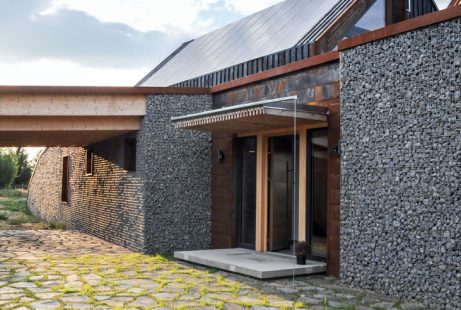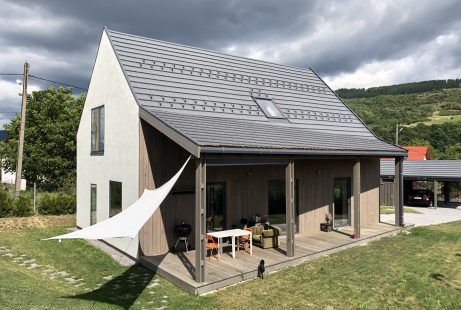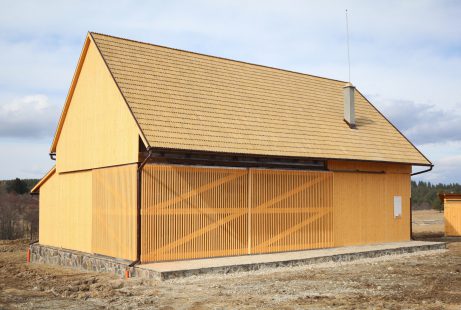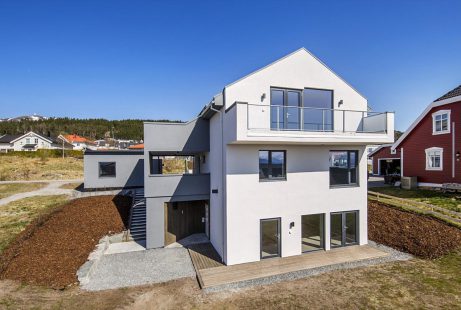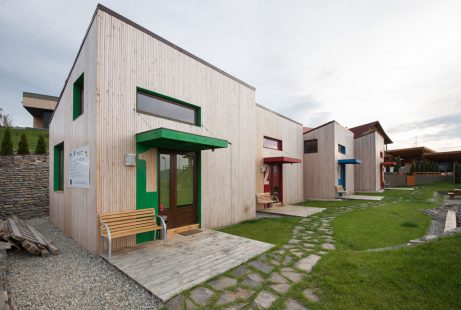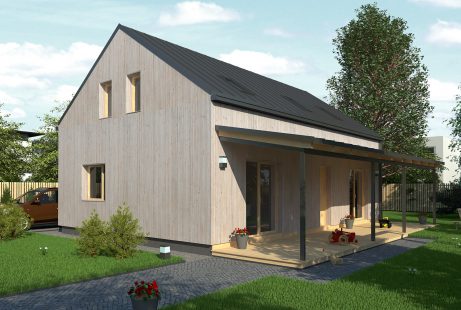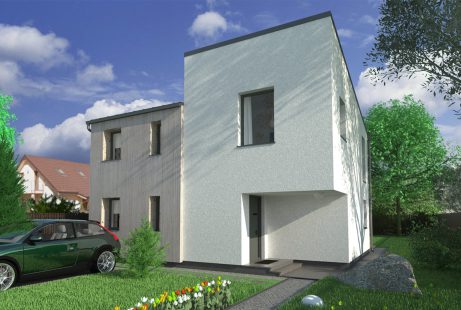Projects
HYPHA_ETC
The architect Alex Whitton, based in Germany, a family friend of the clients, produced a very suggestive concept project in which he described the basic design principles, studied the layout and 3D volumes of the building, proposed the phasing of the design and construction of the building ensemble. Based on this guide and some joint meetings along the way, our office took over the design, we made the detailed technical project, assisted the build-up of the two modules out of the three planned. The complex is located in a quiet village, in the valley of the Niraj creek, a place […]LODGE IN A GLADE
Eco, self-sustainable, green house built in a remote, natural mountain site. The main horizontal topography-volume is partially masked by a sloping green roof and mineral, gabion wall cladding and two traditional barn-like structures are growing from this to break and articulate the huge mass of the construction. The materials and shapes were chosen to blend in the stunning scenery. The building produces and stores most of its energy demands but it isn’t completely off the grid, en electrical connection is made for very cold and cloudy days as a backup system. + natural building materials experience, demanding and confiding clients, straightforward project managemenet and construction […]HAJDO
First sketch pushed through to suddenly get built construction site since 2008, a third kid came along in the owner’s family. Villa merged with the landscape around a south-facing terrace – a core for everyday life – on a steep hill, with great panorama… towards north. The resulting volume is lightened by cuts and floating overhangs and topped by a continuously sloping green roof rising from the landscape. + owner, collaboration with Arnold Macalik (ATELIER FKM ) – 15-20% too big, details didn’t have the time to simplifyTT HOUSE
A simple house with a small twist. The graphic designer client took a consistent part in the design process. Built in a rural environment, the house blends in by its size, shape and plot layout but in the same time it’s not hiding its urban, contemporary origins.J PASSIVE HOUSE
Our first passive house design experience, and also as it turned to be, one of the firsts in Transylvania. Despite difficult orientation, panorama, topography and harsh climate conditions, after several versions, the final layout still managed to be compact, articulated, playfull reaching the passive house parameters and the client’s needs. + consistent documenting/learning process, good collaboration with PHPP specialist – very long construction, some materials proved to be not the best choiceDAFFODIL MEADOW RECEPTION BARN
Similar project to the reception hut models. Nature reserve area for daffodils. The building is an openable stage / shelter for cultural events and wildlife camps. Simple volume inspired by nearby isolated barns. + open-minded client (the mayor), inspiring and beautiful context – complicated and long funding procedure; supervision and maintenance administration unsolved for these remote locations; some details gone wrong during constructionRECEPTION HUT 2
A second refuge (after Tomești) was built in Cârța / Csíkkarcfalva with the help of European tourism development funds. It is a slightly bigger, upgraded version of the prototype, it has restrooms, showers, sewage-water treatment station, surveillance system, photovoltaic panels. This time the roof ridge has been layed parallel to the nearby hillside and the ground floor functions have been partially sunk into this stabilized natural shelter. The site is at a former rural bath (Madicsa), a couple of kms distance from the village, it still has a mineral water spring, used mainly by locals, and it serves as a place for regional events, thematic camps, […]RECEPTION HUT
Rural tourism development funds application feasibility study collaboration for the Szekler region. A type-building has been developed due to short time for application: same timber structure, functional variety under same roof for each of the 8 locations (so far). One has already been built, in Csíkszenttamás / TomeŞti, Harghita county, co-funded by the local administration, County Council, and the Ministry of Regional Development and Tourism. + wooden type-building experience, gets built more or less according to plans – lack of time at pilot project; supervision and maintenance administration unsolved for these remote locationsDUPLEX HOUSE IN NORWAY
Norwegian – Romanian real estate bussiness collaboration for developing a double apartment house in Norway. Lightweight, prefab steel profile structure and interior-exterior gypsum board sheeting system used. + “designing for abroad” experience, new structural system, good project team – not enough design freedom was given at the concept phase, hard to control the constructed details because of the distance, pilot project which needed on-site adjustmentsHEATING PLANT CONVERSION
2008/2009 feasibility study, converting a flat neighbourhood heating plant into an integrated social centre. Went through the evaluation and clarifications process and a financing agreement has been reached between the local administration and the Ministry of Regional Development and Tourism. Building starts in 2011. + due to E.U. funding and control procedures, it’s built according to plans – however, we were allowed 10 days for the execution project and related paperwork4 BUNGALOWS
Near the Hajdó house, the same client needed to extend the capacity of its pension. The 4 small houses are dug into the slope and protected by a massive retainig wall as not to obstruct the nice panorama from the house above. The shapes and materials were chosen in accordance with the newly built environment. + demanding client, good collaboration with Erika Barth and Arnold MacalikT HOUSE 127
Type housing, “model 127” developed in collaboration with Weberbau building company. Home designed for a family with many children, fully equipped living space and personal spaces included.T HOUSE 126
Rural tourism development funds application feasibility study collaboration for the Szekler region. A type-building has been developed due to short time for application: same timber structure, functional variety under same roof for each of the 8 locations (so far). One has already been built, in Csíkszenttamás / TomeŞti, Harghita county, co-funded by the local administration, County Council, and the Ministry of Regional Development and Tourism. + wooden type-building experience, gets built more or less according to plans – lack of time at pilot project; supervision and maintenance administration unsolved for these remote locationsT HOUSE 105
Type housing, “model 105” developed in collaboration with Weberbau building company. Suitable for small plots, twin houses or row house layout.T HOUSE 88
Type housing, “model 88” developed in collaboration with Weberbau building company. Compact model, most efficient plot usage despite its interior space qualities.GRUN’S TRANS
On a former prefab concrete panel production site („house factory”), built during the socialist area, the plots and halls were subdivided after 1990 halt, and property structure fragmented. Our client has bought one half of a hall structure and arranged it step by step, but quite chaotically, as rentable office and production spaces. Our task was to extend and optimise these spaces achieving a unitary look. + planning re-use for an industrial building – very slow design process, not yet built because change of plans / budget


